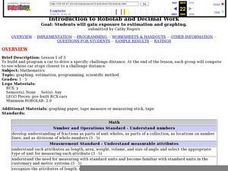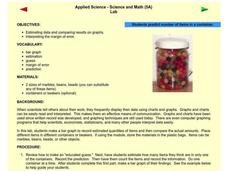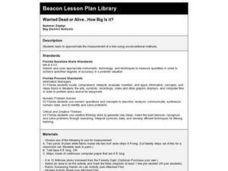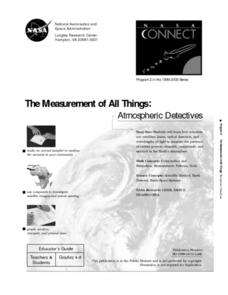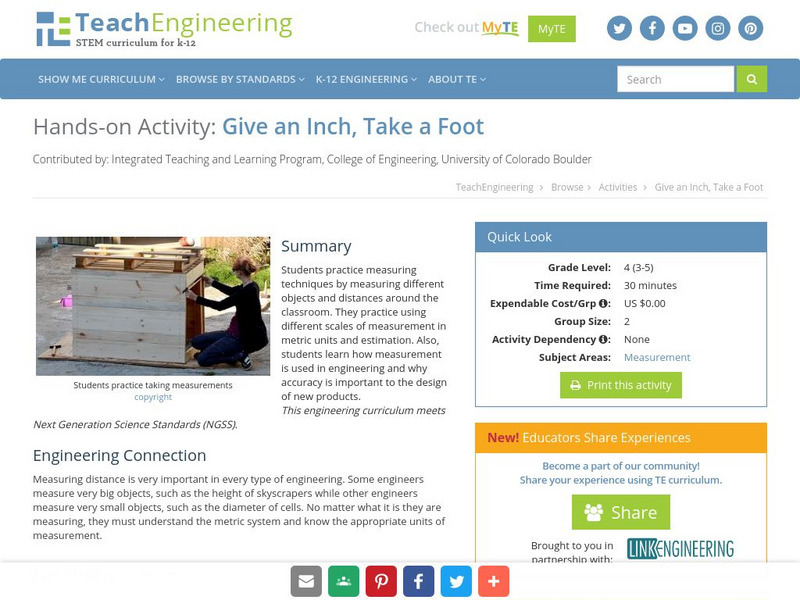Curated OER
Estimation Task
Upper graders practice their estimation skills by observing different objects then making their best guess without using measuring instruments. Learners are asked to estimate mass, length, volume, and area.
Curated OER
Go The Distance Car Construction
Students build and program a car to drive a specific challenge distance.They must at the end of the lesson, have the car that stops the closest to a challenge distance.
Curated OER
By Land, Sea or Air
Young scholars learn navigational techniques change when people travel to different places. They understand differences between navigation on land, water, air and in space. They explain the concept of dead reckoning as it applies to...
Curated OER
Water: From Neglect to Respect
The goal of this collection of lessons is to make middle schoolers more aware of the ways in which they are dependent upon water to maintain their standard of living. Learners compare water use in Lesotho to water use in the United...
Curated OER
Pea Brain! Explorations in Estimation
Students estimate how many peas fit in a container. In this science instructional activity, students calculate the weight of a pea and record it. They use this data to calculate how many peas fit in a human brain.
Curated OER
Applied Science - Science and Math Lab
Students make a prediction. For this applied science lesson, students guess the number of items in a jar. Students create a bar graph to show the predictions and the actual amounts.
Curated OER
Kool Kumara Lesson Plans
Students explore and observe the plant world and acquire knowledge about the functional parts of plants. In this Kool Kumara lesson, students make observations and record specific data on a recording sheet. Students estimation...
Curated OER
How Long Until Dirt
Third graders examine the difference between composting and wasting food. They problem-solve what to do about leftovers after lunches so good food doesn't go to waste.They study food storage techniques that are environmentally friendly...
Curated OER
Wanted Dead or Alive...How Big Is it?
Fourth graders estimate the measurements of trees using unconventional techniques.
Curated OER
What's Cooking - A Colonial Recipe
Eleventh graders explore Colonial and modern techniques, vocabulary, and ingredients of cooking and recipes. They gain understanding of the challenges of cooking in colonial times and modern adaptations.
Curated OER
Ecology and the Conservation of Natural Resources
Pupils examine the habits of various organism and evaluate the need for conserving natural resources. They role-play as migrating birds traveling between habitats encountering hazards along the way. They observe animals in a terrarium...
Curated OER
What Do We Do With A Dirty Bomb?
Students examine composition of dirty bomb and its possible effects on a city, and investigate simulations of such an event; students use computational and problem solving skills to assess damage and prepare report proposing solution to...
University of Georgia
Endothermic and Exothermic Reactions
Equip your chemistry class with the tools to properly understand endothermic and exothermic reactions. Young chemists collect, analyze, and graph data to determine how the Law of Conservation of Matter is applied to chemical...
University of Georgia
Energy Content of Foods
Why do athletes load up on carbohydrates the evening before a competition? The lesson helps answer this question as it relates the type of food to the amount of energy it contains. After a discussion, scholars perform an experiment...
Curated OER
Estimating The Number Of Civilizations In The Milky Way Galaxy
Students estimate the number of civilizations in the galaxy by first estimating the number of craters on the Moon and then by performing estimates of multiple-variable systems culminating in the use of the Drake Equation.
Curated OER
Measuring the Flagpole
Studets practice problem solving and comparison of quantities, ratios and prproportions. They develop a plan for determining the height of a flagpole complete with drawings and calculations. In addition, they complete a written...
Curated OER
Why Are Hot Things Red?
In this radiation and temperature worksheet, students use 2 methods to derive the Wein Displacement law that shows the relationship between the temperature of a body to the frequency where the Planck curve's value is at its maximum....
Curated OER
Hopper Hunt: IPM Decision-making in Alfalfa
Students describe migrations and life cycle pattersn of a key alfalfa pest, the Porato Leafhopper. They define the Economic Inquiry Level and Economic Threshold. Students evaluate data in relation to profit as it applies to IPM. They...
Curated OER
Hibernating Hoopla
Students simulate hibernation with their stuffed animals. They predict the length of time of hibernation and type their math journal entries about sorting, graphing and draw pictures. They read bear hibernation stories.
Curated OER
The Measurement of All Things: Atmospheric Detectives
Young scholars identify the characteristics of aerosols. Using remote sensing, they participate in an experiment in which they determine how the sun's radiation and elements in the atmosphere interact with one another. They also...
Curated OER
LEGO Balance
Students design and build a balance using LEGO, string, and a set of standard metric weights.
Massachusetts Institute of Technology
Mit: Open Course Ware: Introduction to Numerical Analysis for Engineering
College-level electrical engineering course highlighting numerical analysis for engineers. This course introduces students to the formulation, methodology, and techniques for numerical solution of engineering problems. Course features...
TeachEngineering
Teach Engineering: Give an Inch, Take a Foot
Students practice measuring techniques by measuring different objects and distances around the classroom. They practice using different scales of measurement in metric units and estimation. Also, students learn how measurement is used in...

